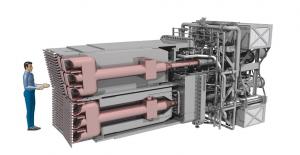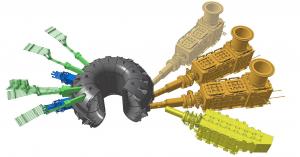"In one transmission line we want to transmit 3 MW. To do this, we use rigid coaxial lines, which are around 300 mm in diameter. The lines use straight runs, bends, and are also fitted with switches and measurement points. The inner conductors are supported by ceramic, and the insulating dielectric gas running inside is controlled and pressurized."
Taking proven technology to new levels
The ITER ion cyclotron is not required for First Plasma, but at the very earliest for the first pre-fusion power operation campaign (beginning December 2028). "It is still years away," says Beaumont. "Even though we're working with proven technology, we're taking that technology to new limits. It's going to take a lot of time to pull it all together with our partners."
ITER Organization is already very busy working to the targets—and so are the three contributing Domestic Agencies: Europe, India and the United States. While the ITER Organization is developing the comprehensive design of the antenna, responsibility for procurement lies with the European Domestic Agency. The preliminary design of the antenna is expected to be completed by the end of 2020, and the final design by the end of 2022.
Europe expects to complete the Radio Frequency Building by the middle of 2020. The ITER Organization is developing the interfaces with the Tokamak Building, ensuring both the confinement and fire zone boundaries at the points where the coaxial cables enter.
The Indian Domestic Agency is providing the radio frequency transmitters and roughly half the high voltage power supplies, customizing existing technology. The ITER Organization will procure the other half of the high voltage power supplies.
The US Domestic Agency is developing the transmission line and matching system, using simulation tools and high-power tests in a dedicated lab. The team there expects to start production soon, to ensure delivery of the transmission lines in time for integration with the transmitter and high voltage power supplies during the assembly phase leading up to First Plasma.
"We're drawing on a big base of knowledge from JET and other experimental reactors that used ion cyclotron systems," says Beaumont. "Using scaling laws, we have taken what has been proven to work and extrapolated to our target power levels and duration. Our ultimate target is to provide power for a pulse lasting 1 hour, with a power amplification ratio (
Q) equal to 5. We're designing the whole system to reach that target."



